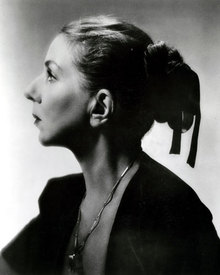The life and influences of Alwin Nikolais
Alwin Nikolais was born on November 25, 1910, in Southington, Connecticut to his German mother and Russian father. His first exposure to art was with the piano that his mother encouraged and he later became involved in a local theater. Later, in 1934, he decided to attend a concert put on by the famous Mary Wigman. Her use of percussion accompaniment excited Nikolais's imagination and sparked his interest. In 1935, Nikolais began his dance education alongside Truda Kaschmann. Kaschmann was a mentee of Mary Wigman and began Nikolais' education in dance because he explained that Nikolais couldn't learn Wigman's technique of percussion accompaniment without understanding dance. From this point on, Nikolais learned more about music, drama, dance, and puppetry along with his education. This early training led to his breakthroughs and innovations later in his choreography.
Nikolais was first introduced to the great innovators, Martha Graham, Doris Humphrey, Charles Weidman, and many others, in 1937. These stimulating influencers peaked his interest in dance and from this point on he was hooked on dance.
In 1939, Nikolais continues his dance journey alongside Truda Kaschmanna and composer Ernst Krenek. His first successful project that really launched his career was the new modern ballet, Eight Column Line, which was very highly praised. This led to Nikolais starting his own dance school and company in Hartford.
In the years between 1942 and 1945, Nikolas was forced to take a break from his dance career when he found himself in the US Army during World War II. But upon discharge, he relocated to New York and resumed dance studies with Hanya Holm and became her assistant.
In 1948, Nikolais joined the Henry Street Settlement where he came to find its school of modern dance and became its artistic director of the playhouse. In 1951, the Nikolais Dance Theater was formed where, in 1953, they presented his first major work, Masks, Props, and Mobiles. In this performance, he used stretch fabric to depict different shapes by using the dancers. More of Nikolais's works included Kaleidoscope, Allegory, Totem, Imago, and many more. He continued experiments with motion, sound, shape, and color. A new way of electronic scoring was also used by Nikolais.
Alwin Nikolais had different values and concentrations in his choreography that was far different from the traditional "dancer centered" way of dance. He was often criticized for his dehumanization of his dancers because he took away their personal appearance and created "decentralized" forms of dance. His innovations in dance made way for the values and practices of modern dance today.
Sources:
https://www.britannica.com/biography/Alwin-Nikolais
https://content.taylorfrancis.com/books/download?dac=C2006-0-05171-5&isbn=9781134955732&format=googlePreviewPdf
Images:
(In order of appearance)
http://www.musicalamerica.com/mablogs/?
https://en.wikipedia.org/wiki/Hanya_Holmp=31100
https://en.wikipedia.org/wiki/Alwin_Nikolais


I enjoyed your blog and review of Alwin Nikolais. One of my favorite parts of Nikolais is learning more about his first major piece of work and how the different props helped him form a feature of dance known as decentralized dance. It is clear that Alvin Nikolais left quite a legacy on dance. By focusing on freedom expression instead of technique, Nikolis was able to have abstract and memorable dances. After reading your blog and researching more about Nikolais, I believe that his unique ideas form dance were influenced by his experience as a puppeteer and silent film artist. He understood the effect new movements could have for years to come.
ReplyDeleteI appreciate the depth you entered here, especially with exploring his early works and lesser known teachers.
ReplyDelete